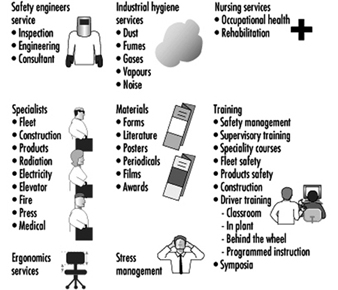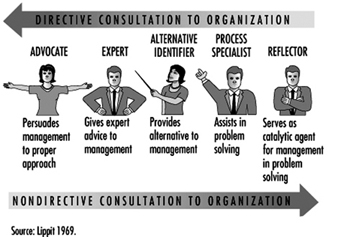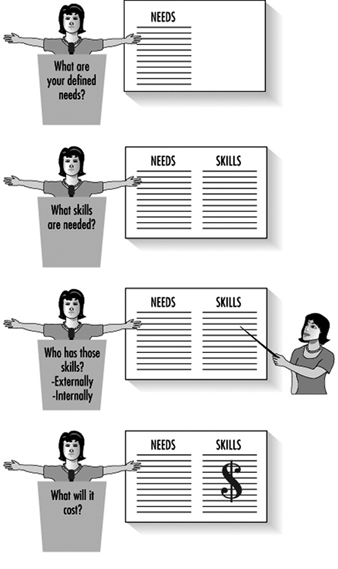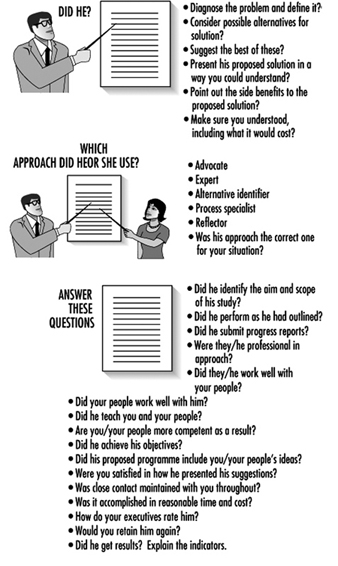Occasionally, those responsible for safety in an organization—whether they be concerned with the behavioural system, the safety system or the physical environment—call upon external resources such as professional safety consultants for help. When this occurs, it is important to bear in mind that the responsibility for the successful completion of the task (as distinguished from the performance of the task itself) of analysing a given system and making improvements to it cannot be delegated to outside agencies. Internal analysts (as opposed to external consultants) studying a system can usually obtain more reliable data because of their close familiarity with the organization. Nevertheless, the help of an outside consultant who has a wide range of experience with analysing safety problems and suggesting appropriate remedies, can be invaluable.
Seeking Outside Help
If there is no one in an organization who is familiar with safety laws and standards on the national level, it might be helpful to call in a safety regulations expert for assistance. Often there is no one in the organizational structure who may be able to analyse the behavioural system, and in such an eventuality it would be advisable to obtain help from someone who can do so. Kenneth Albert (1978) suggests that there are six specific occasions when outside help should be obtained:
- when special expertise is essential
- for a politically sensitive issue
- when impartiality is necessary
- if time is critical and the internal resources are not immediately available
- if anonymity must be maintained
- when the prestige of an outsider would be helpful.
Although Albert’s remarks were not made in connection with safety, the above points seem valid in determining the need for an outside safety consultant. Often a safety problem is intertwined with managerial personalities and is extremely difficult to solve internally. In such a situation a solution may be acceptable to all parties involved just because it came from an outsider. If an organization needs an analysis in a hurry it often can be done faster by an outside consultant, and often the outsider’s recommendation will carry more weight than the insider’s. In the field of safety, it appears that outside help is needed by many organizations with behavioural system analysis, some with safety system analysis and a few with physical condition analysis. However, with regard to the availability of safety consultants, supply and demand are inversely related, as there seems to be an ample supply of physical condition consultants, whereas there are fewer safety system analysts, and safety behavioural analysis experts are almost non-existent.
Safety Consultants
While the types of external safety consultant help will vary by country, they might generally be classified into these categories:
- insurance company field safety engineers or consultants
- government safety consultants (national, state, provincial and local)
- private consulting firms and full-time professional safety consultants
- part-time private consultants
- safety council or safety association consultants
- industry association consultants.
Insurance consultants. Most of the safety consultants and safety engineers in the United States who do not work for government or industry are employed by insurance firms. Many other safety professionals started their careers working for insurance companies. Almost all companies, except the very large and self-insured, are helped routinely by insurance loss-control representatives.
Government consultants. The providers of government consulting services vary from country to country and as to their affiliation (national, state, provincial or local) and the sorts of tasks they are permitted and qualified to perform. In the United States, the stated goal of the onsite consultation programme offered by the Occupational Safety and Health Administration (OSHA) is to obtain “safe and healthful workplaces for employees”. Thus by stipulation, the consultations will pertain only to physical conditions. An organization seeking this kind of help should consider OSHA’s offering. If, however, consulting help is needed with the safety system or the behavioural system, OSHA is the wrong place to go.
The defined onsite responsibilities of OSHA consultants are as follows:
- to identify and properly classify hazards
- to recommend corrective measures (short of engineering assistance)
- to arrange abatement dates for serious hazards
- to report to their supervisors any serious hazards which the employer has not acted upon
- to follow up on employer actions.
It is obvious that there are some aspects of receiving OSHA consulting service by this route that are unusual. The purpose of the consultants is to help improve physical conditions, but in two instances the consultants have additional duties:
- In the case of serious violations of OSHA standards, they must set abatement dates and follow up on them.
- In the case of imminent violations of the OSHA standards, they must refer them to either their supervisors (and thence to the Department of Labor hierarchy) or to the organization’s compliance staff for their immediate action.
In other words, OSHA consulting is true consulting only when nothing seriously wrong is found. If anything serious or imminently hazardous is found, the “customer” loses control of the decision process as to how and when to correct it.
Private consulting firms. A third source of external help is the (full-time) private consultant or the private consulting firms, who can provide help in any area—behavioural systems, safety systems or physical conditions—with none of the special limitations mentioned above. The only difficulty is ensuring that a consultant has been selected who has the necessary skills and knowledge to provide the desired work product.
Part-time private consultation and others. The fourth place to locate a private consultant is among those individuals who consult on a part-time basis to supplement their incomes. These consultants are either retired safety professionals who remain active, or college or university professors who supplement their income and stay knowledgeable about the world outside the academy. Here again the problem is to locate these people and ensure that the person hired has the competencies needed. Additional sources include consultants who make themselves available through national or local safety councils, and consultants with trade associations.
Locating a Consultant
In the first two categories of external help listed above, government and insurance, finding a consultant is easy. For example, in the United States, one can contact the appropriate workers’ compensation insurance carrier or the local OSHA grant office and ask them to visit the organization. Many other countries provide similar governmental and insurance resources.
Finding a consultant in the second two categories, private individual consultants and consulting firms, is more difficult. In the United States, for instance, several organizations publish directories of consultants. As an example, the American Society of Safety Engineers (ASSE) publishes a national directory, which includes some 260 names of consultants. However, there seem to be considerable problems using this directory. An analysis of the 260 people on the list shows that 56% are individuals who indicate that they are for hire but who have not stated whether they work for companies and seek additional income or are full-time consultants or part-time retired safety consultants. An additional 32% were identified as being connected with consulting firms, 5% were connected with universities, 3% were insurance brokers, 3% were connected with manufacturing companies and 1% were associated with state governments. Actually, this directory, while advertised as a document which tells the reader “where the occupational safety/health experts are”, is really a roster of those people who have paid their dues and are members of the consultants division of the ASSE.
There is no easy way to find a consultant who has the expertise needed. Probably the best approaches other than insurance or government are to (1) network with other organizations with similar problems to see who they have used and whether they were satisfied with the results, (2) contact a professional organization at the national level, or (3) make use of professional directories such as the one above, keeping in mind the qualifications made concerning it.
Insurance Consulting
The most readily available of the outside consultants are insurance consultants. Since the beginning of the industrial safety movement, the insurance industry has been involved with safety. For many years. the only possible external help for most companies had been that available from the company’s insurance carrier. While this is no longer true, the insurance consultant is most often sought out.
The safety services departments of typical large insurance companies are charged with three specific functions:
- a sales assistance function
- an underwriting assistance function
- a customer service function.
Only the third of these is of value to the customer needing safety assistance. The underwriting assistance function is carried out by a field representative who is the “eyes and ears” of the insurance company, observing what is going on at the policyholder’s place of business and reporting back to the desk-bound underwriter. The third function consists of assisting customers to improve their loss prevention and safety programmes and reducing the likelihood of those customers having accidents and suffering financial loss. The assistance offered varies considerably from company to company.
Over the years, different philosophies have emerged which dictate the value of the service that the insurance company is able to provide. In some companies the safety services department is still very much a part of the underwriting function and their duties are to observe and report, while in others, the engineering department reports to the underwriting department. In some insurance companies, the loss-control department is independent, existing primarily to serve the customer and only secondarily to assist the sales and underwriting functions. When the primary mission of the service is to assist sales, customer service will suffer. If the loss-control department is part of underwriting, it may be difficult to get safety service from them, as they simply may not be staffed with trained, qualified people to provide that sort of service. If the loss-control department is not part of underwriting, then it may be able to provide good service to a customer. Conversely, it may also be quite ineffective, because numerous factors can intervene that can frustrate the effective provision of safety service.
When the service is an inspection-only service, as is very prevalent, the safety system and the behavioural system will be totally overlooked. When the service consists of the delivery of safety aids and materials, and nothing else, it is a virtually meaningless service. When the service consists primarily or totally of holding safety meetings for a customer, such as delivering the “canned” safety programme that the carrier’s home office has devised for use at all insured companies, or merely ensuring that physical conditions are up to code, it is also a weak service.
Depending upon the sort of philosophy that underlies the service of the carrier, additional services may be available over and beyond that provided by the representative that calls on the customer. Figure 1 outlines some typical additional services that can be particularly useful to customers, such as industrial hygiene, nursing and specialist (engineering and fire protection) services, depending upon the organization’s current needs. Training services are somewhat less common but are also valuable.
Figure 1. Additional services of consultants
Government Consultants
As with the insurance consultants, certain considerations, such as the following, must be weighed by a company before deciding whether or not to request the assistance of government consultants.
- whether the terms under which government assistance is offered are acceptable
- the competence of the people
- the limited scope of the consulting
- the inability to direct the consulting focus.
Probably the first consideration is whether or not a company wishes to become involved with a government at all. When using other kinds of consultants (either private or those provided by an insurance firm), whatever findings are obtained are strictly between the organization and the consultant. Whatever the company decides to do is a decision reserved to the company alone, which retains control over the disposition of the information. With government consultants this is not totally true. For example, if the consultants find one or both of two kinds of hazards—violations of the law and those immediately dangerous to life or health—the organization may not be able to retain the power of decision as to what to do about the hazard and when to do it.
Government consultants can provide assistance with determining whether or not an organization is in compliance with regulations and standards. This is an extremely narrow focus and has many weaknesses, as pointed out by Peters (1978) in his article “Why only a fool relies on safety standards”: “For those who know little about safety, it seems quite plausible and reasonable to expect that the existence of good safety standards and a sufficient conformance to those standards should be an adequate measure of safety assurance.” Peters suggests that not only is such an expectation in error, but also that reliance on standards will subvert professional activities that are needed to reduce loss.
Private Consulting
With the private consultant, whether an independent individual or an employee of a consulting firm, full or part time, there are no mandatory reporting requirements. The private consultant does not have to abide by the mandates of a required referral system; the relationship is strictly between the organization and the individual consultant. The scope of the consultation is limited, as the “customer” can very directly control the focus of the consultant’s activities. Thus the only thing the client has to worry about is whether or not the consultant is competent in the areas where help is needed and whether or not the fee is judged to be a fair one. Figure 2 lists some of the most basic functions of the management consultant.
Figure 2. Basic functions of the management consultant
G. Lippit (1969), who has written extensively on the consulting process, has identified eight specific consultant activities:
- helps management examine organizational problems (e.g., organizes a management meeting for problem identification in the problem relationships between home and field personnel)
- helps management examine the contribution of the proper dialogue to these problems (e.g., in relation to home and field office problems, explores with management how a conference on communication blocks might lead to problem solving)
- helps examine the long- and short-range objectives of the renewal action (e.g., involves management in refining objectives and in setting goals)
- explores, with management, alternatives to renewal plans
- develops, with management, the renewal plans (e.g., based on the objectives, works with a task force to develop a process with built-in evaluation rather than simply submitting an independently developed plan to management for approval)
- explores appropriate resources to implement renewal plans (e.g., provides management with a variety of resources both inside and outside the organization; the renewal stimulator must help management to understand what each resource can contribute to effective problem solving)
- provides consultation for management on evaluation and review of renewal process (e.g., evaluation must be in terms of problem solving; working with management; the renewal stimulator must assess the current status of the problem, rather than check whether or not certain activities have been conducted)
- explores with management the follow-up steps necessary to reinforce problem solving and outputs from the renewal process (e.g., encourages management to look at implications of the steps taken so far, and to assess the current status of the organization in terms of other actions that might be necessary to follow up on implementation of the renewal process).
Lippit (1969) has also identified five different positions which the consultants can adopt vis-à-vis their clients’ needs (Figure 3).
Figure 3. Five consultant approaches
Choosing a Consultant
When choosing a consultant, a process such as that given by figure 4 is suggested.
Figure 4. Choosing a consultant
Whether or not to use a consultant, and which one to use, ought to be determined by the user’s defined needs and by what kinds of skills and knowledge the consultant must have to be of real help. Then, it would seem logical to look for individuals or groups that have those sorts of skills and knowledge. It may be determined that as a result of this process, the job can be done without external help; for example, to locate the needed skills internally and apply those skills to the defined safety problems. Conversely, it may be decided to go to the outside for the skills needed.
Evaluating the Consultant’s Performance
After having worked with consultants for a period of time, a company can judge their individual performance and worth to the organization much more accurately (figure 5). As a result of the analysis provided by the consultant, the conclusion may be made that perhaps the remainder of the job, or a similar job, can be done as well using internal resources. Many companies do this now, and more are turning to it, in both safety and nonsafety areas.
Figure 5. Evaluating the consultant's performance
Problem-Solving Approaches
K. Albert, in his book, How to Be Your Own Management Consultant (1978), suggests that there are four different types of internal management problem-solving approaches:
- to hire a full-time internal consultant
- to put someone on a special assignment on a temporary basis
- to create a task force to work on a problem
- collaboration between an outside consultant and an internal consultant.
Furthermore, Albert suggests that no matter which approach is chosen, these ground rules must be followed for success:
- Get total support of top management.
- Establish confidentiality.
- Earn the acceptance of operation units.
- Avoid company politics.
- Report to a high level.
- Start slowly and maintain objectivity.





